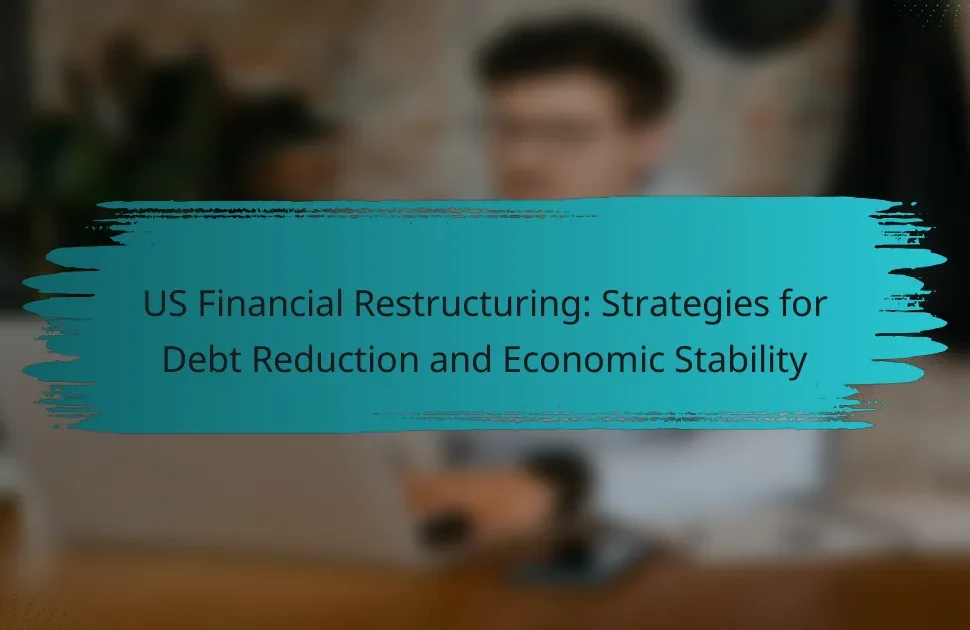US Financial Restructuring is the process of reorganizing a company’s financial framework to enhance stability and viability, particularly during financial distress or bankruptcy. This process often involves Chapter 11 bankruptcy proceedings, allowing companies to renegotiate debts while maintaining operations. Key benefits include debt reduction, improved cash flow, and the potential for long-term economic recovery, as evidenced by historical cases like General Motors and American Airlines. Stakeholders can navigate this landscape by understanding regulations, analyzing market conditions, and utilizing technology for informed decision-making, ultimately fostering innovation and growth in the economy.

What is US Financial Restructuring?
US Financial Restructuring refers to the process of reorganizing a company’s financial structure to improve its stability and viability. This often occurs during periods of financial distress or bankruptcy. The goal is to reduce debt, improve cash flow, and restore profitability. In the U.S., this process is commonly facilitated through Chapter 11 bankruptcy proceedings. During these proceedings, companies can renegotiate debts with creditors while continuing operations. Historical examples include major corporations like General Motors and American Airlines. These restructurings can lead to long-term economic recovery by allowing businesses to emerge stronger and more competitive.
How does US Financial Restructuring impact the economy?
US financial restructuring impacts the economy by enhancing stability and promoting growth. It reallocates resources more efficiently, allowing for better capital distribution. This process can lead to increased investor confidence, which stimulates economic activity. Historical instances, such as the 2008 financial crisis, demonstrate that effective restructuring can mitigate downturns. For example, the Troubled Asset Relief Program (TARP) helped stabilize major banks, preventing further economic collapse. Additionally, restructuring often results in stronger regulatory frameworks, which can lead to sustainable long-term growth. Overall, these changes can create a more resilient economic environment.
What are the key components of US Financial Restructuring?
The key components of US Financial Restructuring include debt restructuring, asset reallocation, and regulatory reform. Debt restructuring involves renegotiating existing debt obligations to improve financial stability. This process often includes extending payment terms or reducing interest rates. Asset reallocation focuses on optimizing the use of resources to enhance productivity and profitability. This may involve divesting non-core assets or investing in high-growth areas. Regulatory reform aims to create a more resilient financial system by addressing systemic risks. It includes revising regulations to promote transparency and accountability in financial institutions. These components collectively aim to stabilize the economy and support recovery efforts.
How does financial restructuring differ from other economic strategies?
Financial restructuring primarily focuses on reorganizing a company’s financial obligations and capital structure. This strategy aims to improve liquidity, reduce debt, and enhance overall financial health. Unlike other economic strategies, which may target market expansion or operational efficiency, financial restructuring specifically addresses solvency issues. It often involves negotiations with creditors, asset sales, or changes in equity ownership. Historical examples include companies like General Motors, which underwent restructuring to emerge from bankruptcy in 2009. Such actions are distinct because they prioritize immediate financial stability over long-term growth plans.
Why is US Financial Restructuring necessary?
US Financial Restructuring is necessary to address systemic risks and inefficiencies in the financial system. A significant factor is the need to stabilize financial markets after crises, such as the 2008 financial crisis. Restructuring can enhance regulatory frameworks, ensuring that financial institutions operate more transparently and responsibly. Additionally, it aims to improve access to capital for businesses and consumers, fostering economic growth. Historical data shows that effective restructuring can lead to increased investor confidence and market stability. For instance, post-crisis reforms have been linked to a more resilient banking sector. Overall, restructuring is essential for promoting sustainable economic recovery and preventing future financial turmoil.
What economic factors drive the need for financial restructuring?
Economic factors driving the need for financial restructuring include declining revenues, increased debt levels, and market volatility. Declining revenues occur due to reduced consumer spending or economic downturns. Increased debt levels can lead to unsustainable financial obligations. Market volatility affects business stability and investor confidence. Additionally, changes in regulations and rising operational costs can necessitate restructuring. For instance, during the 2008 financial crisis, many companies faced these pressures, leading to widespread restructuring efforts.
How do crises influence the restructuring process?
Crises significantly influence the restructuring process by creating urgent needs for change. During a crisis, organizations often face financial instability and operational disruptions. This urgency forces decision-makers to reassess strategies and prioritize efficient resource allocation. For instance, the 2008 financial crisis led many companies to restructure to enhance liquidity and reduce debt. Research shows that firms that proactively restructure during crises tend to recover faster. According to a study by the National Bureau of Economic Research, timely restructuring can improve long-term profitability. Therefore, crises act as catalysts for necessary organizational transformations.
What challenges are associated with US Financial Restructuring?
US financial restructuring faces several significant challenges. One major challenge is the complexity of existing financial systems. These systems involve numerous stakeholders, including banks, investors, and government entities. Coordination among these parties can be difficult and time-consuming.
Another challenge is the potential for economic disruption. Financial restructuring may lead to job losses and reduced consumer spending. This can negatively impact economic growth.
Regulatory hurdles also present challenges. Changes in policies can create uncertainty for businesses and investors. This uncertainty may hinder investment and economic recovery.
Additionally, public perception plays a role. Citizens may distrust financial institutions and government actions. This skepticism can affect the implementation of restructuring plans.
Lastly, the need for adequate funding is crucial. Restructuring often requires substantial financial resources. Without sufficient funding, efforts may stall or fail to achieve desired outcomes.
What are the common obstacles faced during restructuring?
Common obstacles faced during restructuring include resistance to change, lack of clear communication, and inadequate planning. Resistance to change often arises from employees fearing job loss or altered roles. Lack of clear communication can lead to misunderstandings and decreased morale among staff. Inadequate planning results in unforeseen challenges that can derail the restructuring process. Additionally, financial constraints may limit the resources available for effective restructuring. Stakeholder disagreements can further complicate the process, causing delays and conflicts. These obstacles can significantly hinder the success of restructuring efforts.
How do political and regulatory environments affect restructuring efforts?
Political and regulatory environments significantly influence restructuring efforts. These environments dictate the legal framework governing business operations. Changes in regulations can either facilitate or hinder restructuring processes. For example, favorable tax policies may encourage investment during restructuring. Conversely, stringent regulations can create obstacles, increasing costs and complexity. Political stability often correlates with successful restructuring outcomes. A stable political climate fosters investor confidence, essential for attracting capital. In contrast, political uncertainty can lead to hesitation among stakeholders. Historical data indicates that companies in politically stable regions tend to recover faster from financial distress. Thus, the political and regulatory landscape plays a crucial role in shaping the success of restructuring initiatives.

What opportunities does US Financial Restructuring present?
US Financial Restructuring presents opportunities for economic recovery and stability. It allows for the reallocation of resources to more productive sectors. This process can lead to improved corporate governance and operational efficiencies. Financial restructuring often results in debt reduction, which enhances liquidity for businesses. The restructuring can also attract new investments, fostering innovation and growth. Additionally, it provides a framework for renegotiating unfavorable contracts. Historical instances, such as the restructuring during the 2008 financial crisis, demonstrate these benefits. Overall, US Financial Restructuring can rejuvenate struggling sectors and contribute to broader economic recovery.
How can financial restructuring lead to economic recovery?
Financial restructuring can lead to economic recovery by improving the financial health of distressed companies. This process often involves debt reduction, asset sales, and operational improvements. By stabilizing businesses, financial restructuring helps restore investor and consumer confidence. Increased confidence can lead to higher investment levels and consumer spending. Additionally, a healthier corporate sector can create jobs and stimulate economic growth. Historical examples, such as the restructuring of the automotive industry during the 2008 financial crisis, demonstrate how targeted financial interventions can revitalize key sectors. Thus, financial restructuring serves as a catalyst for broader economic recovery.
What sectors stand to gain the most from restructuring?
The sectors that stand to gain the most from restructuring include technology, healthcare, and renewable energy. Technology companies can enhance efficiency and innovation through restructuring. The healthcare sector can improve service delivery and reduce costs by streamlining operations. Renewable energy is poised for growth due to increasing demand for sustainable solutions. According to a McKinsey report, these sectors are likely to attract significant investment during economic recovery phases. Restructuring can lead to a more agile and competitive landscape in these industries.
How does restructuring foster innovation and growth?
Restructuring fosters innovation and growth by realigning resources and processes within an organization. It enables companies to adapt to market changes and improve efficiency. This process often leads to the identification of new opportunities and the elimination of outdated practices. For example, a study by McKinsey & Company found that companies undergoing restructuring often experience a 20% increase in productivity. Enhanced collaboration among teams can also emerge, driving creative solutions. Furthermore, restructuring can attract investment by demonstrating a commitment to modernization. This approach ultimately supports sustainable growth by positioning firms to respond effectively to consumer demands.
What role do stakeholders play in the restructuring process?
Stakeholders play a critical role in the restructuring process. They include employees, management, creditors, shareholders, and customers. Each stakeholder has unique interests that influence the restructuring outcomes. Employees may seek job security and benefits. Management focuses on operational efficiency and profitability. Creditors aim to recover debts and minimize losses. Shareholders are concerned about investment returns. Customers want product continuity and service quality. Engaging stakeholders fosters transparency and builds trust. Effective communication with stakeholders can lead to better decision-making. Research shows that stakeholder involvement can improve restructuring success rates. For example, a study by Harvard Business Review indicates that companies with strong stakeholder engagement experience fewer disruptions during transitions.
How can collaboration among stakeholders enhance outcomes?
Collaboration among stakeholders enhances outcomes by fostering shared goals and resources. Engaging diverse perspectives leads to more innovative solutions. Stakeholders can leverage their unique strengths for greater efficiency. This collective approach can reduce duplication of efforts and costs. Studies show that collaborative initiatives often yield higher success rates. For example, a report by the Brookings Institution found that partnerships in economic recovery efforts improved local job creation by 30%. Effective collaboration also builds trust and accountability among stakeholders. This trust can facilitate smoother implementation of initiatives and policies. Overall, collaboration is essential for maximizing impact and achieving sustainable economic recovery.
What are the implications for investors and consumers?
Investors may face increased volatility and risk in the market due to financial restructuring. This can lead to changes in asset valuations and investment strategies. Consumers could experience shifts in credit availability and interest rates as institutions adapt. Financial institutions might tighten lending standards, impacting consumer borrowing. Additionally, restructuring could lead to new regulations that affect market dynamics. For example, the Dodd-Frank Act introduced measures to increase transparency and accountability in the financial sector. This has implications for both investors and consumers regarding market confidence and economic stability.
What successful case studies exist in US Financial Restructuring?
Successful case studies in US financial restructuring include General Motors, which emerged from bankruptcy in 2009. The company restructured its debts and operations, receiving $50 billion in government aid. This intervention allowed GM to return to profitability within a few years. Another example is Chrysler, which also filed for bankruptcy in 2009. Chrysler underwent significant restructuring and received $12.5 billion in federal loans. It successfully merged with Fiat, leading to a stronger market position. Additionally, the restructuring of American Airlines in 2011 resulted in a debt reduction of $2 billion. This allowed the airline to improve its financial health and operational efficiency. Each of these cases demonstrates effective financial restructuring strategies that led to successful recoveries.
What lessons can be learned from these case studies?
Case studies on US financial restructuring reveal critical lessons for economic recovery. One key lesson is the importance of timely intervention. Historical examples show that early action can mitigate deeper economic crises. Another lesson is the need for comprehensive policy frameworks. Effective policies must address both immediate financial needs and long-term economic stability. Additionally, stakeholder collaboration is essential. Successful restructuring often involves cooperation between government, private sectors, and communities. Lastly, adaptability is crucial. Case studies highlight that flexible strategies can respond to evolving economic conditions. These insights underscore the multifaceted approach required for effective financial restructuring.
How do these examples inform future restructuring efforts?
Examples of financial restructuring highlight effective strategies for future efforts. They demonstrate the importance of adaptive frameworks. Successful case studies reveal lessons in risk management and stakeholder engagement. For instance, the 2008 financial crisis led to regulatory reforms that improved transparency. These reforms can guide future restructuring by emphasizing accountability. Additionally, analyzing past failures can identify common pitfalls to avoid. The role of technology in streamlining processes is also evident from previous examples. Implementing these insights can enhance resilience in future financial systems.

How can stakeholders navigate the US Financial Restructuring landscape?
Stakeholders can navigate the US Financial Restructuring landscape by understanding key regulations and market conditions. They should analyze the impact of the Bankruptcy Code and the role of the Federal Reserve. Stakeholders must stay informed about economic indicators that influence restructuring outcomes. Engaging with financial advisors can provide insights into best practices and strategies. Networking with other stakeholders can help share knowledge and resources. Monitoring industry trends is crucial for anticipating changes in the financial landscape. Utilizing technology for data analysis can enhance decision-making processes. These strategies enable stakeholders to effectively manage risks and leverage opportunities in financial restructuring.
What best practices should be followed during restructuring?
Best practices during restructuring include clear communication, stakeholder engagement, and strategic planning. Clear communication ensures that all parties understand the reasons for restructuring. Stakeholder engagement helps to gather input and foster support. Strategic planning involves setting clear goals and timelines. Additionally, conducting a thorough analysis of financial health is crucial. This analysis should identify areas for cost reduction and revenue generation. Implementing a phased approach can facilitate smoother transitions. Regularly monitoring progress allows for adjustments as needed. These practices enhance the likelihood of successful restructuring outcomes.
How can effective communication improve restructuring outcomes?
Effective communication can significantly enhance restructuring outcomes by fostering transparency and trust among stakeholders. Clear communication ensures that all parties understand the reasons for restructuring. It helps to align goals and expectations, which can reduce resistance to change. Regular updates can keep employees informed and engaged during the process. Research shows that organizations with strong communication practices are 50% more likely to achieve successful restructuring. This is because effective communication mitigates uncertainty and anxiety, leading to a more cooperative environment. By addressing concerns proactively, leaders can facilitate smoother transitions and better overall results.
What strategies can mitigate risks during the restructuring process?
Implementing clear communication strategies can mitigate risks during the restructuring process. Transparency helps to manage stakeholder expectations. Regular updates can reduce uncertainty and build trust. Engaging employees in the process fosters collaboration and minimizes resistance. Conducting thorough risk assessments identifies potential issues early. Establishing a contingency plan prepares the organization for unforeseen challenges. Utilizing external advisors provides expertise and an objective perspective. Monitoring progress continuously allows for timely adjustments to the strategy.
What resources are available for understanding US Financial Restructuring?
Key resources for understanding US Financial Restructuring include academic journals, government reports, and financial analysis platforms. Academic journals such as the Journal of Financial Economics provide peer-reviewed articles on financial restructuring theories and practices. Government reports from the U.S. Department of the Treasury offer insights into policy changes and economic impacts. Financial analysis platforms like Bloomberg and Reuters deliver real-time data and expert analysis on restructuring trends and case studies. Additionally, books such as “Corporate Financial Distress and Bankruptcy” by Edward I. Altman provide foundational knowledge and empirical research. These resources collectively enhance comprehension of the complexities involved in US Financial Restructuring.
Where can stakeholders find expert insights and analyses?
Stakeholders can find expert insights and analyses in financial research publications and industry reports. These sources often provide in-depth evaluations of economic trends and restructuring strategies. Reputable financial institutions and consulting firms regularly publish white papers and case studies. Academic journals also feature peer-reviewed articles on financial restructuring topics. Additionally, industry conferences and webinars offer platforms for experts to share their analyses. Online databases and financial news platforms provide real-time insights and expert opinions. Accessing these resources can equip stakeholders with valuable knowledge for informed decision-making.
What tools can assist in assessing restructuring opportunities?
Financial modeling software can assist in assessing restructuring opportunities. These tools allow organizations to create detailed financial projections. They help analyze various scenarios and their potential impacts. Common examples include Excel, Adaptive Insights, and Oracle Hyperion.
Data analytics platforms also play a crucial role. They enable companies to gather insights from large datasets. Tools like Tableau and Power BI provide visualization capabilities. This enhances decision-making processes during restructuring.
Consulting services are another valuable resource. Firms like McKinsey & Company and Boston Consulting Group offer expertise in financial restructuring. They provide tailored assessments and strategic recommendations.
Lastly, benchmarking tools can help compare performance against industry standards. These tools assist in identifying areas for improvement. They support informed decisions regarding restructuring initiatives.
What are the key takeaways for stakeholders involved in US Financial Restructuring?
Key takeaways for stakeholders involved in US Financial Restructuring include understanding the importance of collaboration. Stakeholders must work together to create effective solutions. Clear communication is essential for navigating complex financial landscapes. Stakeholders should also be aware of regulatory changes that could impact restructuring efforts. Financial data analysis is crucial for informed decision-making. Stakeholders need to assess risks and develop contingency plans. Engaging with affected communities can enhance the restructuring process. Lastly, stakeholders should focus on long-term sustainability rather than short-term fixes.
US Financial Restructuring is the process of reorganizing a company’s financial structure to enhance stability and viability, often during financial distress or bankruptcy. This article examines the impact of financial restructuring on the economy, highlighting its role in promoting growth, improving resource allocation, and restoring investor confidence. Key components such as debt restructuring, asset reallocation, and regulatory reform are discussed, along with the challenges and opportunities that arise during this process. Additionally, the article explores successful case studies, the implications for stakeholders, and best practices for navigating the complexities of financial restructuring.




